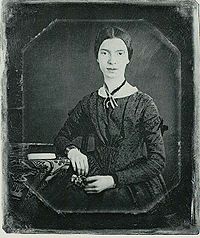
Frye liked to say that he intended his work to be treated as a source of isolated insights that might help others, even if one felt reluctant to swallow the rest whole. He was thinking of something as simple as assisting a reader or scholar in the business of practical criticism.
I just had the experience of that usefulness as I was working today on a reading of a poem by Emily Dickinson for today’s class. The poem is the famous “Dare you see a Soul at the White Heat?”
Dare you see a Soul at the White Heat?
Then crouch within the door—
Red—is the Fire’s common tint—
But when the vivid Ore
Has vanquished Flame’s conditions,
It quivers from the Forge
Without a color, but the light
Of unanointed Blaze.
Least Village has its Blacksmith
Whose Anvil’s even ring
Stands symbol for the finer Forge
That soundless tugs—within—
Refining these impatient Ores
With Hammer, and with Blaze
Until the Designated Light
Repudiate the Forge—
And here is the illuminating passage from Frye’s Words with Power:
The smith often represents a destructive force, as apparently in Zechariah 1:20. In this verse the AV reads “carpenters”: in Biblical Hebrew it is sometimes difficult to distinguish the worker in wood from the worker in metal except by the context. But just as there can be benevolent carpenters, like the New Testament Joseph and traditionally Jesus himself, so there can be creative smiths, like the forger of the new Jerusalem in Isaiah 54:16. This smith, who creates a new city glowing with gems and gold, represents perhaps the closest Biblical parallel to the symbolism of alchemy, and is the Biblical basis for Blake’s conception of his culture-hero, the blacksmith Los working with his furnaces.
The image of the furnace may be used for either the negative or positive aspects of the lower world. The negative or demonic world is the traditional hell which is a furnace of heat without light. The positive one is purgatorial, a crucible from which the redeemed emerge purified like metal in a smelting operation. Thus the Egypt from which Israel has been delivered is spoken of several times as a “furnace of iron,” and the purity of the spiritual body is sometimes symbolized by metal (Revelation 1:15). Images of refinement and purification in a furnace recur in connection with language (Psalm 12:6) as well as in the afflictions of life (Proverbs 17:3; Isaiah 48:10). The best known of these purgatorial furnaces is the one constructed by Nebuchadnezzar for his attempted martyrdom of the three faithful Jews in the Book of Daniel. Their song in the Apocrypha is a highly concentrated praise to God for the beauty and glory of the original creation, which their purification in the furnace has evidently enabled them to see. Obviously, in this extension of furnace symbolism, we have modulated from the technological to the purgatorial, and the furnace has become the human body.
Dickinson was often focused on that moment called the transitus–the transition from this world to immortality or eternity–which she treated with awe. She came to conceive of her life of passionate longing and loss as a crucible, which is also how she thought of her poetry: as a purgatorial process, a refining of the “impatient ores” of her intense emotional life into artistic form. Hence her persistent emphasis on the moment of transit when “the Designated Light/Repudiate the Forge.” She often thought of this process in Blakean terms: of preparing her ultimate“face” or “form” in the mirror of the human form divine.
Frye’s essay on Dickinson and his seminal essay “Charms and Riddles” are replete with startlingly useful insight about the literary conventions used by Dickinson, but this particular instance illustrates the way in which Frye’s “ear” for archetypes–in this case the biblical furnace archetype that is the focus of last chapter of Words with Power–is enormously helpful in unpacking the richest implications of the imagery of a poem, implications that might otherwise elude us. Dickinson’s poem takes a simple New England blacksmith’s forge, which even the “least village” has, and makes it the most apposite analogy for the purgatory–as the poet conceived it–of human life and the perfecting of the human soul through poetry and art, awakening, if we have the ear for it, all the echoes and reverberations–in the Bible, in Dante, in Blake and Yeats’s Byzantium–that the conventions of a particular archetype, as Frye puts it in The Secular Scripture, “set up within our literary experience, like a shell that contains the sound of the sea.”
